After thirty years, I thought it was about time for an update of “My Family Search in Ireland (June 1986).” Certainly research has become a lot easier with so much primary source material now available for free or a small fee online. I had never even heard of the Internet back in 1986 and the World Wide Web wouldn’t be invented until 1989. Yet, despite all the advances in information availability, our understanding of Robinson story in Ireland has not really advanced much.
After coming back from the United States, I did do quite a bit of work on the immigrant James Robinsocoln and his descendants which you can read about in “A Family Story: The Robinsons of Plaquemines Parish.” This research overall I think strengthens the connection between James Robinson and the other Robinsons in Annaghdown Parish. In addition to his obituary and the stories told to Michael Curran by his aunts, I found that James Robinson’s wife, Mary Burke, also came from Annaghdown Parish. Her parents, Patrick Burke and Mary Collins, married in Menlough Parish, County Galway on 18 December 1824 but had moved to Annaghdown Parish by the time Mary was baptized on 2 November 1835. It seems likely that this Patrick Burke may be the Patrick Burke who leased a house and land in Aucloggeen Township along with John Robinson.
Indeed, there seems to have been a close connection between the Burke, Collins, Costello, and Robinson families in Annaghdown Parish. John Robinson was a witness at the marriage of Patrick Collins in 1842 and of James Costello and Anne Burke in 1844. Patrick Collins was a sponsor for the baptism of Mary Burke in 1838 and John & Maria Costello were sponsors for the baptism of Patrick Burke in 1843, both children of Patrick Burke and Mary Collins. While I certainly cannot vouch whether this Patrick Collins was one and the same person or whether the family members mentioned were closely related, these kinds of clues do provide some additional support a link between John Robinson of Annaghdown Parish, County Galway, and James Robinson of Plaquemines Parish, Louisiana.
As for clues from Robinson descendants in the United States about the Irish roots of the Robinson family, my research turned up nothing. Most of the living descendants of James Robinson did not really even know their ancestor was from Ireland. Even the ones who had heard that the Robinsons were Irish tended to doubt it since Robinson was an English name. James’s oldest son, William Edward Robinson, who probably was in the best position to learn stories of the Old World and pass them on to the next generation (see below), claimed the Robinsons were English. Even if they believed the Robinsons were Irish, none of the descendants knew from where in Ireland the Robinsons came.
As for the Robinson descendants in Ireland, Michael and I corresponded a few times but neither he nor I pursued any of the possible leads that I had recommended back in 1986. And quietly the Irish research just ended. I am certain that most of the older people I met in my visit to County Galway – like my cousin Michael Curran, John Craven, Mr. Mitchell, and the Hennellys – have passed away in the intervening thirty years and taken with them whatever else they might have been able to share with us. But I am indeed blessed that I did get a chance to talk with them while they were alive and record at least some of what they knew.
I read that Curran’s Hotel burned down in December 2002. The papers reported that the hotel had been sold for €4.3 million the previous April. Apparently the building was left unoccupied and there were some reports that homeless people moved into the hotel and they may have been responsible for the fire that destroyed the top two stories of the four-story hotel. 1

In 2005 my wife Jennifer and I took a honeymoon trip to Ireland. We planned a trip to travel all around the coast of the island, staying in bed and breakfasts and rented houses. But this time I rented a car! Of course, one of the places we would be driving through was County Galway. Indeed we had found a wonderful place, Delphi Lodge, in the northern part of the county only 8 miles from Leenaun where we planned to stay for five days and use as a base of operations. As we drove through Galway City from the south, I was shocked how much the city had changed in only twenty years. Ireland was undergoing a huge economic boom (some would say bubble) and there was construction going on everywhere.
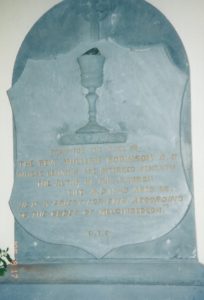
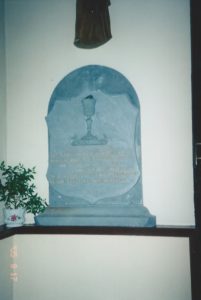
The direct route to the Delphi Lodge went right past the Kilmilkin Church so I naturally stopped in to see in the plaque to William Robinson was still there. Sure enough, the plaque was there but they had nicely moved it inside where it wouldn’t suffer any further weathering.
 On one of the day trips we went out to see the Cliffs of Moher and on the way back I talked Jennifer into making a side trip to see if it looked like what I remembered. I especially was interested in seeing if I could find where the old Robinson pub was. I realized that I never really did see where the site was. I remembered it was where the six roads came together at the source of the Cregg River but I never went back to Aucloggeen after getting a good look at the historic map of Aucloggeen in Galway City.
On one of the day trips we went out to see the Cliffs of Moher and on the way back I talked Jennifer into making a side trip to see if it looked like what I remembered. I especially was interested in seeing if I could find where the old Robinson pub was. I realized that I never really did see where the site was. I remembered it was where the six roads came together at the source of the Cregg River but I never went back to Aucloggeen after getting a good look at the historic map of Aucloggeen in Galway City.
Even though it had been twenty years, we didn’t have GPS, and the map we had wasn’t detailed enough to show the side roads, I thought my memories were strong enough that I could find my way there. Going up N17 I saw the sign for Annaghdown much as I had seen it back in 1986 and I took the road down to the abbey ruins and memorial to the 1828 boating accident. But when I tried to retrace my way to Corrandulla Church to get my bearings I took the wrong road and got totally lost. Just as with Galway City, there had been a lot of new construction in this area and nothing looked familiar.

Eventually we came to the old 19th-century mill called Cregg Mill on the Cregg River and I convinced myself that Robinson’s pub must have been on the other side of the road from the mill, next to the river, land which was now quite vacant.
I parked the car and walked out onto the vacant land and found a concrete slab which I decided must have been the foundation of the old pub. After I took a couple of pictures of what I took to be the location of Robinson’s pub, Jennifer started complaining about my taking photos of nothing. So I left it at that and we headed back to Leenaun.
In 2017, I returned once again to trying to figure out about what I could about the Irish Robinsons. And with all the old maps now online and google maps it didn’t long to figure out where Robinson’s pub was and how very wrong I had been in 2005. It was actually quite simple. John Craven had told me some thirty years earlier that Fahy’s pub stood on the exact site that Robinson’s pub after the old pub was torn down in the 1970s. And, guess, what! There is still a pub on the exact same site in 2017, although now it is called Peggy’s!
If Jennifer and I had continued down the road from here we were at Cregg Mill in 2005 just another half a mile, we would have seen the pub and I could have easily recognized where the six roads converged. But I realized I just didn’t remember ever seeing Fahy’s pub and just didn’t realize that a pub had been on this same spot continuously since the days of John Robinson!
 I messaged, Aiden Leonard, the manager of Peggy’s and he confirmed that the present management renovated the interior of Fahy’s but the exterior was essentially the same. He also mentioned that there are plenty of locals who still speak of the old two-story thatched roof pub.
I messaged, Aiden Leonard, the manager of Peggy’s and he confirmed that the present management renovated the interior of Fahy’s but the exterior was essentially the same. He also mentioned that there are plenty of locals who still speak of the old two-story thatched roof pub.

But you can bet that if I ever get back to Ireland again, I will be sure to stop and have a good Irish breakfast at Peggy’s!
A couple of weeks after I had contacted Aiden Leonard, I found through my father that Nancy Siegel, a Robinson cousin living in California, had earlier been in contact with Aiden and he had actually sent her a scan of a photograph of the old pub!
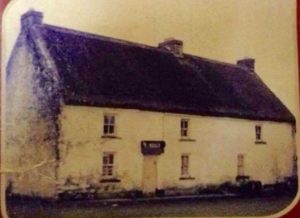
Subj: Robinson’s Pub
Hi Bruce,
Attached is an old photo of John Robinson’s two-story thatched roof pub in Aucloggeen, Annaghdown Parish, County Galway, opened by John around 1822. This photo was provided to me by Aiden Leonard, the current owner of Peggy’s Bar, Lounge and Restaurant, the successor to Robinson’s. It was taken when it was run by John’s granddaughter and called Kelly’s.
As Bruce Jr found out during his research, my GGG-GF John Robinson sold the pub to his daughter Margaret and her husband Thomas Mullrey when John and his son James Robinson (my GG-GF) left for America in the 1840s. Margaret’s daughter, also named Margaret “Peggy”, married John Kelly. They later took over the pub and renamed it Kelly’s Pub. At some point in the 1970s it burned down and was rebuilt as a single story structure. It stayed Kelly’s until the late 1970s or 80s when it was sold and became Fahy’s. It was sold again 12 years ago and became Peggy’s. Aiden says that some old timers still refer to Kelly’s Pub!
Recently I re-read Bruce‘s report of his trip to Annaghdown. He mentioned Aucloggeen, so I started searching online for any pubs in Aucloggeen. Peggy’s came up. On a hunch I checked Facebook, and yes — Peggy’s has a FB page! I sent a private message and the rest, as they say, is history. The menu at Peggy’s looks quite good.
In his report, Bruce Jr mentioned an old etching he was shown of the thatched roof pub. Was it this photo that he saw? Or is there another picture out there we should search for?
More later re Burke and Collins.
Best regards,
Nancy
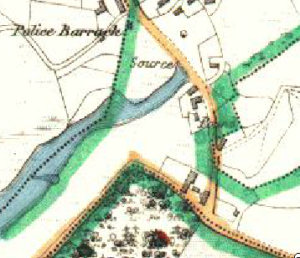
You can see that Robinson’s pub was in the exact same location on the 1839 map (now online!), the three buildings at the Y in the road in the southeasternmost corner of Aucloggeen Townland.
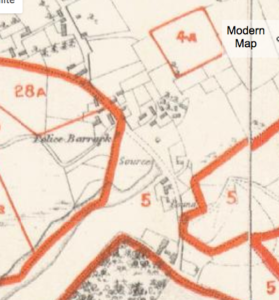
I was also able to mine more information out of Griffith’s than I had in 1986. I had not realized thirty years ago that there were maps that went with Griffith’s that showed the exact location of the holdings of the tenants. The maps were the same as the 1839 townland maps but there were no numbers on the 1839 map. 2
If you go to
http://www.askaboutireland.ie/griffith-valuation/
you can enter any family name and you will see a list of every entry with that family name who was in Griffith’s Valuation list. You can narrow the search by county (and further barony, poor law union, and parish) if desired. You can then click on any listing and see the original print page with that listing. Alternately you can click on the listing and see the original map showing the location of the listing. You can zoom in and zoom out of map and, furthermore, switch back and forth between the historical map and the modern map as well as different versions of the historical map.
As I found back in 1986, John Robinson’s land in Aucloggeen was listed in Griffith’s under both #1 and #5. The upper map (at the top center of the map) shows #1 was just land (14 acres, 2 roods, 2 perches) valued at 3L.15 with no house. #5 on the table is divided up among 16 different landowners and their separate holdings were not differentiated on the map. However, 13 of these 16 share in 106 acres with individual land and buildings valued at different amounts. The other three (Bridget Mulrooney, John Robinson, Honoria Kellehan) under #5 do not have land listed, only house, garden, and (for Robinson) offices. Mulrooney’s lot size was 38 perches, Robinson 16, and Kellehan 12. And yet Robinson buildings on this land were valued as much as the Aucloggeen church. These must be the three buildings seen at the bottom center of the lower map, in the exact same location as Patty’s bar today.
In addition the upper map shows Nineacres (bottom center-right) where John Robinson leased all 16 acres, 1 rood, and 38 perches. Nineacres borders on Aucloggeen and is about 650 feet away from the fork in the road where the pub stands.
In addition to Lewis, other topographical dictionaries gave more information about life in Annaghdown Parish lists “Aughelogun” [sic] as one of the two principal villages in that parish. 3
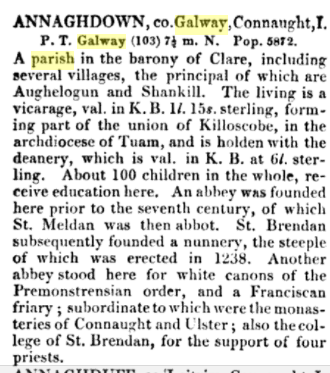
Annaghdown is a vicarage in the dio. of Tuam. . . The church, situated in Annaghdown, was built about the year 1798, was built about the year 1798, by meas of a gift . . . from the late Board of First Fruits. Sittings 200; average attendance, fro 12 to 20. The Annaghdown Roman Catholic chapel is attended by from 600 to 700; the Woodpark school-house, used as a Roman Catholic chapel, is attended by 125; and they have jointly two officiates. There are chapels also in Lackagh and Killascobe. In 1834, the Protestants of Annaghdown parish amounted to 27, and the Roman Catholics to 6,504; the Protestants of the united parishes to 43, and the Roman Catholics to 11,458; the day-schools of Annaghdown parish to 8, and the day-schools of the union to 16, with 374 boys and 185 girls. 6
It is a lot easier doing Irish genealogy today with all the easily accessible online sources that weren’t available in 1986.
The Roman Catholic parish registers that I looked at with such difficulty in Dublin now all online to look at with difficulty. Here’s the online entry for Annaghdown Parish” at http://registers.nli.ie/parishes/1041
Archdiocese of Tuam | County of Galway
Microfilm 04222 / 03
Microfilm 04219 / 05
But what has made the job of locating individuals in these parish registers even easier is that local genealogical societies across Ireland have created databases of the names in almost all of the 19th-century Catholic and Protestant parish registers. The parishes in West Galway were done by Galway Family History Society West (http://www.galwayroots.com/west/home) while the parishes in East Galway were completed by East Galway Family History Society (http://www.galwayroots.com/east/home). These databases are keyword searchable, for a fee, at http://www.rootsireland.ie/
To compare, I spent hours at the National Library in Dublin staring at all the Roman Catholic records for the parish of Annaghdown for the years 1834-1868 and found not a single record for Robinson which led me to suspect the Robinsons were Protestant. But doing a search for “Robinson” in Annaghdown Parish records on http://www.rootsireland.ie/ immediately found four records with the name Robinson in the marriage records for these years that I had simply missed. (At least I was right that there was no mention of Robinson in the baptismal records!)

Witness 3: William Allen
The most significant entry in the Annaghdown Parish register is, of course, that of the marriage of Thomas Mulry and Margaret Robinson which quite clearly demonstrates that Margaret Robinson was a Roman Catholic. Although it is not clear who the John Robinson was who was witness to these three weddings, the odds are it is to the John Robinson who we believe was Margaret Robinson’s father, the only John Robinson we have evidence of as resident in Annaghdown Parish.

As to who this Bridget Robinson is who witnessed two marriages with John Robinson, it would seem likely that she is John Robinson’s wife. Since the name “Bridget” was not one used by the descendant’s of John Robinson in naming their children, we can presume Bridget was not the mother of John Robinson’s children, a daughter, or a sister. Rather it seems like that Bridget was the second wife of John Robinson.
If John Robinson’s daughter Margaret was Roman Catholic it is almost a certainty that John Robinson was Catholic. In the 1911 census, marriages between Catholics and Protestants comprised less than 1% of the marriages in Ireland and one can imagine that number was even lower in the early 19th century. 7 This was the kind of evidence I was looking for in the National Library back in 1986. If I had seen this back then, I would not have gone to the lengths I did to pursue the Protestant Robinsons, as fascinating as it was to learn about them.
Finding solid evidence that the Annaghdown Robinsons were Catholic also gives greater strength to the story of the two priests, William Robinson and Edward Robinson. But there is still is the problem of trying to find a direct connection between the Annaghdown Robinsons and these two priests.I could find no new insights from online sources to confirm the story of the two priests. Indeed no evidence has been found in Ireland apart from the stories that Michael Curran said he heard from his aunts and there is the possibility that his aunts could have heard about plaques to priests named Robinson from people who stopped in at the pub and the aunts simply adopted the priests as their own, imagining the whole scenario.
However, I still find intriguing the fact that James Robinson named his first son William Edward Robinson, rather than John Robinson (after his father) or Patrick Robinson (after Mary Burke’s father). In addition, there was one other story I learned in my American research that I think lends strong support to the story of William and Edward Robinson. And this comes from a person who surely would have known the story if anyone, William Edward Robinson himself.
Although William Edward Robinson said the Robinsons were English and seemed to want to distance himself from Ireland, he must have heard many tales of County Galway from both his mother and father. William Edward was a young man around 19 years old when his father died. Furthermore William Edward lived until the ripe old age of 84 so he had plenty of years to pass on his memories to his grandchildren. I spent an afternoon with one of William Edward’s grandchildren, James F. Mullen, shortly after coming back from Ireland and he regaled me with all the stories that he remembered his grandfather telling him. And one of the stories that James Mullen remembered was that William Edward would say that his grandfather would have no trouble getting into heaven because he had one son who could fight his way into heaven and another son who could pray his way into heaven. James always thought that meant William’s grandfather had one son who was soldier and another son who was a priest, but James did not remember any more detail than that. He did not, for example, ever hear his grandfather saying that he was named after two priests who died young. And yet this fits the story of John Robinson (William Edward’s grandfather) because he did have a son (James) who was a soldier and it makes the story of having another son who was a priest more believable.
Whether John’s priest son was the William or Edward or both for whom we have plaques is another matter. William was a common enough name among Robinsons in Tynagh Parish (see below) but Edward was not. Perhaps only William Robinson and not Edward was John’s son. Perhaps John named his son Edward after his wife’s father but we do not know the name of John’s wife. Further complicating the matter is that the only evidence we had that the priest’s name was actually Edward was Mr. Mitchell in Menlough Parish back in 1986 and we never learned the source of his information.
Still taken altogether – the stories of Michael’s aunts, the black plaques, James naming his first son William Edward, James Mullen’s story about the soldier and priest – lend a lot of credence to the story of the two priests, enough to continue to tell the story until proven not to be true.
When she got married in 1848, Margaret Robinson undoubtedly would have been married in the Corrandulla Church (also known as St. Brendan’s) which I discovered was actually built in 1837 at the same time the Robinsons were living in the area. 8 When I was staying at the Hennellys I didn’t think the Corrandulla Church was that old but now that I realize how old it was and that the Annaghdown Robinsons were definitely Catholic, I have a greater appreciation that the Corrandulla Church was the parish church that the Robinsons must have attended.
As for Church of Ireland records for Annaghdown Parish, Brigid Clesham had written me back in 1986 that she had found no mention of Robinsons in the Annaghdown Parish records. In 1987 the parish sent what records they did have covering the years 1850-1897 to the Representative Church Body (RCB) Library in Dublin which must have been the records Brigid had looked through for me back in 1986. The great loss is that “a register of baptisms 1800 & 1811-77, marriages 1815-56, and burials 1835-56 was destroyed in the fire in the Public Record Office of Ireland in 1922.” 9
As to where John Robinson of Annaghdown came from, we have very little evidence. There are pockets of Robinsons all over Ireland. If we stick just to other parts of Galway there are at least four clusters of Robinsons in the early 19th century: Galway City, Loughrea, Tynagh, and Tuam. The Galway, Loughrea, and Tuam Robinsons are heavily if not exclusively Church of Ireland, leaving only Tynagh as a possible point of origin. In addition, both John Craven and Michael Curran believed that the Robinsons came from Tynagh Parish. 10
From the Tynagh Parish Roman Catholic register, I was able to identify the following Robinsons as adults in Tynagh in the early 19th century who could have been siblings or 1st cousins of John Robinson.
(1) Michael Robinson
m. 20 Feb 1814 Mary Connaughton Tynagh Parish
(2) James Robinson
m. Cecilia “Cisly” Cavanagh
(a) Margaret bapt. 16 May 1817 Tynagh Parish
(b) Michael bapt. 1 April 1820
(c) Michael bapt. 26 February 1822
(3) James Robinson
m. Catherine “Kitty” Burke
(a) Mary bapt. 15 May 1818 Tynagh Parish
(b) John bapt. 22 Feb 1820 Tynagh Parish
(c) Catherine bapt. 21 July 1822 Tynagh Parish
(d) Anne bapt. 18 March 1825 Tynagh Parish
(e) Catherine bapt. 23 October 1832 Tynagh Parish
(f) Samuel bapt. 18 June 1835 Tynagh Parish
(4) Mary Robinson
m. 6 February 1817 John Murphy Tynagh Parish
(5) Samuel Robinson
m. 10 November 1822 Hannah Newton (from Aughrim, Galway) Tynagh Parish
(6) Samuel Robinson
m. Catherine Burke
(a) James bapt. 18 July 1827 Tynagh Parish
(b) Mary bapt. 27 March 1830 Tynagh Parish
(7) Mark Robinson
m. 20 July 1823 Mary Mitchel
(a) Michael bapt. 19 February 1825 Tynagh Parish
(b) John bapt. 21 June 1826 Tynagh Parish
(c) Martin bapt. 14 November 1830 Tynagh Parish
(d) Patrick bapt. 10 February 1833 Tynagh Parish
(e) Catherine bapt. 27 April 1834 Tynagh Parish
(f) Margaret bapt. 26 October 1835 Tynagh Parish [mother listed as Maria lnu]
(8) William Robinson
m. Mary Egan
(a) Maria Ann Robinson bapt. 22 April 1819 Tynagh Parish
(b) William bapt. 17 November 1834 Tynagh Parish
(9) Matthew Robinson
[sponsor to baptism of Maria Ann Robinson 22 April 1819 Tynagh Parish, dau. of William Robinson and Mary Egan]
(10) Anne Robinson
[sponsor to baptism of Maria Ann Robinson 22 April 1819 Tynagh Parish, dau. of William Robinson and Mary Egan]
(11) John Robinson
m. Mary “Biddy” McDaniel
(a) John bapt. 14 May 1826 Tynagh Parish
(b) James bapt. 27 July 1828 Tynagh Parish
(c) William bapt. 3 May 1832 Tynagh Parish
The fact that there are two different men named James Robinson and two others named Samuel Robinson at about the same stage in life in the 1820s suggests that there are at least two Robinson lines in Tynagh Parish, perhaps descended from Robinson brothers who either came with their father or moved together to Tynagh Parish. And if there were two Jameses and two Samuels there may very well have been two Johns since John was probably the most common name in Ireland at the time. The fact that only one John shows up in Tynagh Parish suggests possibly that the other John Robinson moved away. It isn’t too far of a reach that this John Robinson moved to Annaghdown Parish, especially considering the popular belief in Annaghdown Parish that the Robinsons came from Tynagh.
As to who the fathers of these Robinsons were, including the father of the John Robinson of Annaghdown, it is anybody’s guess. One might guess John, James, or Samuel, since parents tended to name children after themselves and their own parents. However, the Tynagh Parish records peter out before 1810 so other sources would have to be used to determine the names of earlier Robinsons.
There are many other websites that offer access to other databases that might be worth checking out. I should mention that Paul Greaney has published useful information about genealogical research in Annaghdown Parish on his blogspot, including slides from a talk he gave on 22 November 2016 called “Tracing Your Annaghdown Ancestors: Talk on 22/11/2016.”
Tracing Your Annaghdown Ancestors: Talk on 22/11/2016
Keyword searchable copies of 19th-century newspapers are also increasingly being made available online for a fee at various websites. One website “Irish Newspaper Archive” (https://www.irishnewsarchive.com/) has keyword searchable copies of the Tuam Herald (13/05/1837 – Current). A search for the keyword “Robinson” for the years 1837-1880 came up with 95 entries but a search for the keywords “Robinson Annaghdown” or “Robinson Annadown” came up with 0 entries. So did a search for “Aucloggeen” or “Aughlogeen”.
Another site “The British Newspaper Archive” has keyword searchable copies of the Galway Mercury, and Connaught Weekly Advertiser for the years 1844-1860 (as of July 2017). A search for the keyword “Robinson” found 351 entries. A search for the keywords “Robinson Annaghdown”, “Aucloggeen” and “Aughlogeen” found 0 entries. However a search for “Robinson Annadown” came up with 3 entries, one of which was extremely interesting from Galway Mercury, and Connaught Weekly Advertiser for 27 March 1852. Paul Greaney had already published this particular entry on his blog. 11
1852 – Electors, Barony of Clare and more
PUBLIC MEETING
We, the undersigned, request a Meeting of the Electors of the Baronies of Ballymoe, Dunmore, Tiaquin, and Clare, to be held in the Court House, TUAM, on TUESDAY, 30th instant, for the purpose of considering the most effectual means of securing at the coming election, the return to Parliament of gentlemen who will fairly and honestly represent the feelings of this great county, and of enlisting in favour of the same object the friendly aid and active co-operation of the Electors in the other baronies.
+JOHN, Archbishop of Tuam.+John, Bishop of Clonfert.Michael D. Bellew, Bart. MountbellewM.J. Blake, M.P., Ballyglunen ParkJohn J. Bodkin, D.L. J.P., KilclooneyMartin S. Kirwan, D L. J P., BlindwellCornelius J O’Kelly, J.P., GallaghJames Kirwan, J.P., GardenfieldHenry Blake, J.P., BallinaD. Rutledge, J.P. MountbernardGeorge Lynch, RockwellMichael G. Lynch, RockwellJames Ronayne, FlaskaghJames Ronayne, jun. doWilliam Lynskey, CoolickaleaPatrick Conry, R C C, Presbytery, TuamEugene Coyne, R C C, doPatrick Corcoran, R C C, do
Patrick Duffy, P P, DunmoreMichael Gibbons, P P, KilconlyJohn Burke, P P, MoyloughPatrick Lyons, P P, SpiddalJames O’Rorke, C C, DunmoreAnthony Mogan, C C, doDominick Lynch, CarabegJames Hanly, ThomastownThomas Bodkin, F.R.C.S.I., TuamJohn Prendergast, M.D. doJohn F. Butler, M.D. MountbellewPatrick Kelly, Grove House, TuamMichael Kelly, Mire HillWalter Blake, Ross LodgeHugh McHugh, TuamMichael Fahy, T C, TuamFrancis Waldron, T C, TuamDominick Tully, DerrymoreMichael Roche, AbbeytownCharles Grant, CloonaghmoreTimothy Hanly, ThomastownHenry Kirwan, HillsbrookThomas Keaveny, P.P. AnnadownPatrick Wade, Cregg MillsWilliam Cavanagh, AnnadownJohn Robinson, doMartin Creaven, doPatt Collins, doRichard Sheridan, doJohn Cahill, doJames Browne, doMathias Curran, doJohn Gardner, doGeorge Commins, doJ. Commins, doJohn Cullinane, MountbrownePeter Roche, CastlehackettPatrick Roche, CaltraJohn Loftus, P P, DonaghpatrickThomas Curran, C.C. doPatrick Magauran, P.P., AhascraghFerdinand Waldron, C.C, MountbellewJohn Tully, doHugh Mullarkey, doMichael Moran, doMichael Fitzpatrick, doWilliam Bodkin, doDominick Bodkin, doJoseph Kelly, KinclairWilliam Gannon, T.C. TuamThomas Bodkin, TullinadalyPeter Waldron, P.P., LackaghRichard Kearney, doRichard Burke, doJohn McDonagh, doThomas Caulfield, doWilliam Badger, doPatrick Kearney, doJohn Hession, doPatrick Shaughnessy, doLuke Shaughnessy, doMartin Shaughnessy, doPeter Reynolds, St. Jarlath’s College, TuamJohn McEvily, doThomas Keilty, doP.J. O’Brien, doP.T. Burke, C.T.C., TuamFrancis Corbett, doTimothy Geraghty, doWilliam F. Kelly, T.C., doM.S. Mitchell, T.C. doT.E. Miller, do.James Kyle, doPeter Burke, doPatrick Waldron, doJames Dwyer, T.C., doCharles L. Davis, doJohn Ryan, doPeter O’Flanagan, doMartin Cloran, doMichael J. Costello, T.C., doT. W. Murray, L.C., doJohn Moylan, doJohn Daly, T.C., doJohn Morris, do.Richard Walsh, P.P., HeadfordJohn Browne, ClaranJoseph Dooly, CloughanourTobias Laffy, P.L.G. do
Morgan Morris, doPatrick Laffy, doPatrick McDonagh, DunmoreJohn Cavanagh, P.P., KillererinThomas Moran, C.C. doJohn Moran, C.C., MilltownJohn E. Donelan, ProspectPatrick Commins, BarnaPatrick Hanly, doMark Connelly, doWilliam Murphy, doWilliam E. Donnellan, DunmoreWilliam Costello, High-street, GalwayMartin McDonnell, DunmoreJames Loftus, doJohn Kelly, doJohn Collins, doEdward GIlmore, doPatrick Garry, GlanamaddyF. Blake Foster, ClareviewC.A. Bagot, BallymoeJohn S. Barrett, Ballintava
James French, Waterslade PlaceCharles Blake, jun., ThornhillThomas Higgins, Attorney, TuamRichard Kelly, Proprietor Tuam HeraldDominick Tully, Mount TellyP. Duggan, R.C.A, CorofinThomas Hughes, doWilliam Mulloy, CloughPat Ryan, BallykeaghColl Rochfort, GalwayPETER REYNOLDSWM. GANNON,Hon. Secs.
John Robinson’s inclusion on this petition along with the Archbishop of Tuam and Bishop of Clonfert suggests that John Robinson of Annaghdown man of some standing and substance. As to what this petition suggest about John Robinson’s religion or politics it is not clear. Resentment on both religious and economic grounds toward the British government in the years following the Great Famine led to the emergence of the Independent Irish Party, also known as the Irish Brigade, in July 1852, just four months after this petition. According to Wikipedia,
The Independent Irish Party had two central aims:
-
The repeal of the Ecclesiastical Titles Act, which banned Roman Catholic Bishops from re-assuming pre-reformation ecclesiastical bishopric titles in the United Kingdom, as well as the prohibition of the wearing of clerical outfits.
-
The adoption and enforcement of the Three Fs, namely
-
fair rent;
-
fixity of tenure;
-
free sale. (These would all have aided Irish tenant farms, all of whom lacked them.)
-
The 48 elected MPs who formed the Irish Brigade came almost exclusively from the central part of Ireland, including the 2 MPs from County Galway. (See maps below.)

Fortunately, things have gotten much better for the old Tuam Cathedral (St. Mary’s) since when I saw it in June 1986 as the photos and video show below. According to wikipedia, there were “some major renovations” between 1985 and 1993 and now the cathedral is open to visitors on Friday during summer months as well as Sunday services. Here is a video of a recent virtual tour of the interior of the cathedral.

Cregg Castle is also doing much better and is now open to houseguests. Here’s the advertisement on Airbnb:
About the space
Cregg Castle is a magical place built in 1648 by the Kirwin Family, one of the 12 tribes of Galway. It is set on 180 acres of pasture and beautiful woodlands.
Your host, Artist Alan Murray who currently hosts the Gallery of Angels in the main rooms.
Sounds like a great deal!
Notes:
- “Galway city centre hotel destroyed by fire,” Dec. 17, 2002, https://www.irishtimes.com/news/galway-city-centre-hotel-destroyed-by-fire-1.452457; Lorna Siggins, “Gardai investigate Galway hotel blaze, Dec. 18, 2002, https://www.irishtimes.com/news/gardai-investigate-galway-hotel-blaze-1.1108459 ↩
- For an explanation of the terms used in Griffith’s Valuation, see http://www.findmypast.ie/articles/griffiths-valuation—explanation-of-terms?_ga=1.238327622.739302107.1411396829 ↩
- John Gorton, ed., A Topographical Dictionary of Great Britain and Ireland, 3 vols. (London: Chapman and Hall, 1833) 1: 50. The Irish and Welsh articles were done by G.N. Wright. ↩
- John Gorton, ed., A Topographical Dictionary of Great Britain and Ireland, 3 vols. (London: Chapman and Hall, 1833) 1: 50. The Irish and Welsh articles were done by G.N. Wright. ↩
- The Parliamentary Gazetteer of Ireland, Vol. 1, A-C (Dublin: A. Fullarton, 1846) 109 ↩
- The Parliamentary Gazetteer of Ireland, Vol. 1, A-C (Dublin: A. Fullarton, 1846) 35. ↩
- “Marriage rate between Catholics and Protestants under 1% in 1911,” The Irish Times, Jan. 30, 2015,” https://www.irishtimes.com/news/social-affairs/religion-and-beliefs/marriage-rate-between-catholics-and-protestants-under-1-in-1911-1.2084775 ↩
- “Notice to Builders,” Galway Patriot, Oct. 18, 1837, http://paulgreaney.blogspot.com/2015/03/1837-corrandulla-church-notice-to.html ↩
- http://ireland.anglican.org/cmsfiles/pdf/AboutUs/library/registers/ParishRegisters/ABC/AnnaghadownParishRegisterList.pdf ↩
- As with Annaghdown Parish, there are no Church of Ireland extant records for Tynagh Parish for the early 19th century. Two volumes of parish registers, comprising baptisms (1815-1878), marriages (1819- 44), and burials (1824-69) that were sent for safekeeping to The Public Record Officer in Dublin were destroyed in the 1922 fire. Remaining parish records from the years 1855-1934 were sent to the RCB Library in 2007. See http://ireland.anglican.org/cmsfiles/pdf/AboutUs/library/registers/ParishRegisters/PQRSTUVWZ/TynaghParishRegisterList.pdf ↩
- http://paulgreaney.blogspot.com/2015/03/1852-electors-barony-of-clare.html ↩
- https://en.wikipedia.org/wiki/Independent_Irish_Party ↩
- https://www.airbnb.com/rooms/8522681 ↩





